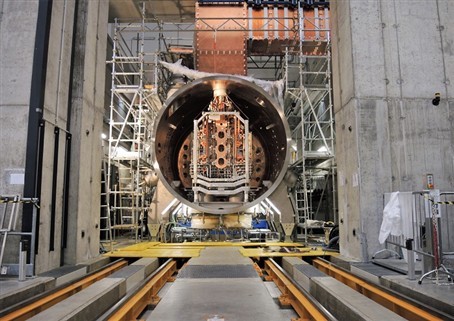Europe is ready to switch on SPIDER – the most powerful negative ion source experiment to date


The final countdown for the operation of SPIDER has started. All its systems are connected and engineers together with scientists are getting ready to turn the switch on and start testing. It’s the result of a successful international collaboration of various Parties, from inside and outside Europe, working together to bring fusion energy a step closer. The thinking behind this experiment is similar to that of ITER: various components had to be produced in different parts of the world, and subsequently they had to be assembled in a facility specifically built for it. What started as an idea on paper is now an operational state-of-the-art test bed that will improve our knowledge on ITER heating systems and help us manufacture them.
Financed mostly by F4E, and with contributions from Consorzio RFX, ITER International Organization, and India’s ITER Domestic Agency, this is the first of the two experiments/test beds at ITER’s Neutral Beam Test Facility located in Padua, Italy. A second one called MITICA, which will mimic the full power of the ITER injectors, also under the same roof a few metres away, will be operational in a few years from now.
SPIDER, which stands for Source for Production of Ion of Deuterium Extracted from Radio Frequency plasma, will help engineers to finalise the development of the ion sources required for the ITER Neutral Beam Injectors (NBI), and to test key aspects of the diagnostic neutral beam accelerator. This is the first full-scale ITER ion source, capable of running pulses of up to 3 600 seconds at maximum power with hydrogen or deuterium. The 6 MW beam generated for one hour by 1280 powerful beamlets are equivalent to the energy required by roughly 1 000 medium apartments in one day.

An army of F4E suppliers and subcontractors worked hard to deliver various components of the SPIDER experiment. A European consortium consisting of Thales Electron Devices SA, CECOM Srl, Galvano-T GmbH, and E.Zanon SpA has been responsible for the manufacturing of the beam source and its vacuum, which weighs about 5 t and measures 3 x 3 x 2 m, and of its vacuum vessel. Works started four and a half years ago, for value of 10 million EUR approximately, which also includes the costs for the fabrication of the vacuum vessel and handling tool. OCEM Energy Technology and COELME provided the power supplies that will energise SPIDER. The cooling plant was delivered by Delta Ti Impianti, and the vacuum and gas injection plant system by Angelantoni Test Technologies. Last but not least, URS and NIER offered valuable engineering support. ITER India collaborated with PVA Tepla for the beam dump and with ECIL for the accelerator grid power supplies. Consorzio RFX in collaboration with the Italian authorities undertook the construction costs of the buildings, and procured diagnostics and control systems which were agreed in collaboration with F4E.
To understand the importance of this milestone, which has also been highlighted by the ITER Council, the political body that brings together all ITER Parties to monitor the overall progress, we need to make sense of history. We spoke to Tullio Bonicelli, F4E’s Head for Neutral Beam, Electron Cyclotron and Power Supplies Systems, who has been following the evolution of this project the last 15 years. “Early in 2000 when the fusion community was finalising ITER’s engineering design activities, the conclusion was reached that specific R&D activities were required to develop the neutral beams. In 2005, J. Potočnik, European Commissioner for Research, and L. Moratti, Italy’s Minister for Education, Universities and Research, reached an understanding to host in Italy the Neutral Beam Test Facility. EFDA (European Fusion Development Agreement) was asked to set the wheels in motion and Consorzio RFX, in Padua, was selected as the Host of the experiment.
As soon as F4E was established the EU responsibility of the project was transferred to us. Until the end of 2011, we were busy trying to convert the concept of the facility into a concrete project involving also ITER International Organization. In a way, it felt like putting together a mini ITER. From 2012 onwards, we opened a new chapter making this facility a reality and laying the foundations of a legal framework to channel our contribution. Thanks to a dedicated team of 20 people bringing on board their expertise from the fields of engineering, planning, quality assurance, project management, law and procurement, today F4E has honoured its contribution vis `a vis all other Parties involved in this facility. We have come a long way, if you think about it…and now the exciting part for the fusion community starts with testing”.
